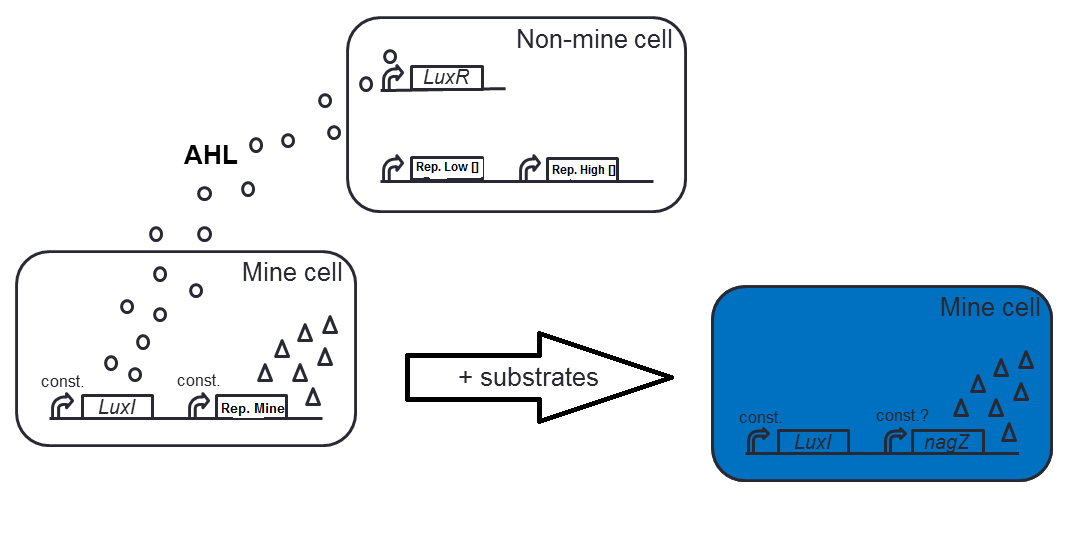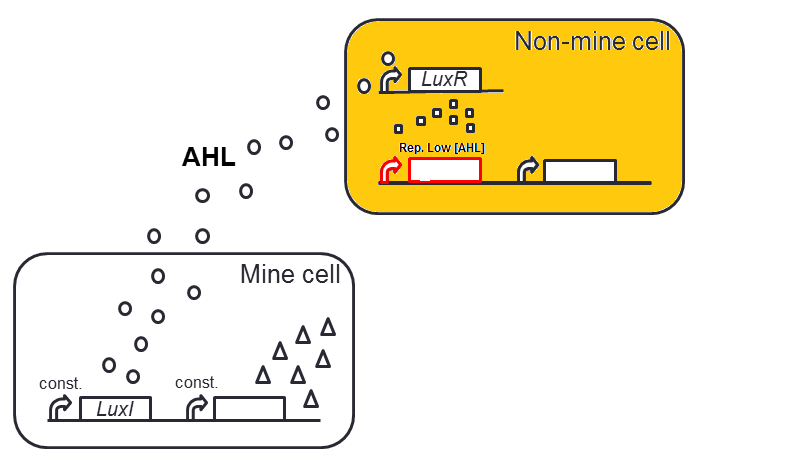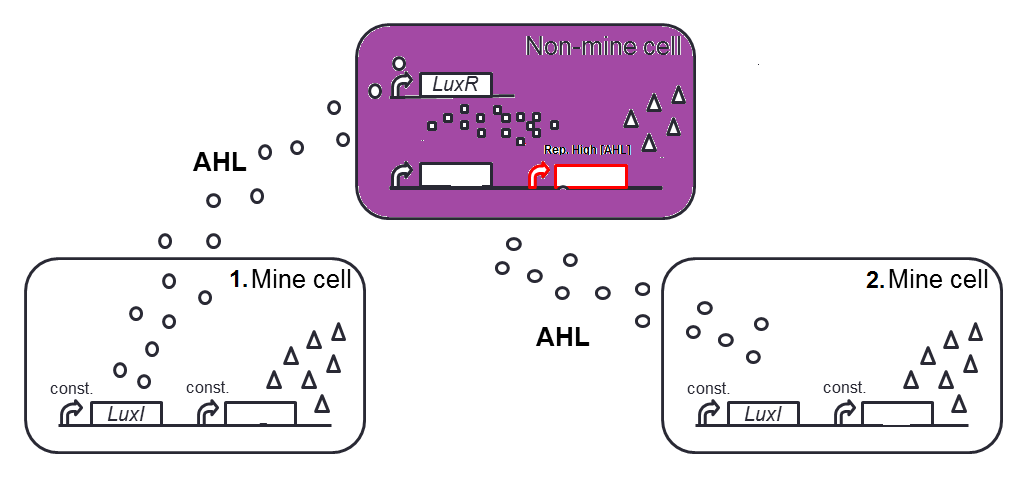Team:ETH Zurich/Project
From 2013.igem.org
| Line 39: | Line 39: | ||
<br><br> | <br><br> | ||
We can be sure our bacteria aren’t cheating!! :) | We can be sure our bacteria aren’t cheating!! :) | ||
| + | <br clear="all" /> | ||
| - | |||
| - | |||
= '''MINE CELLS(aka sender cells)''' = | = '''MINE CELLS(aka sender cells)''' = | ||
[[Image:Minecellfunction.png|500px|left]] | [[Image:Minecellfunction.png|500px|left]] | ||
Mine cells are a strain of E.coli bacteria that constitutively express the "mine-cell reporter” reacting with substrate #1 to produce the visual effect of being a mine. After substrate #1 is added the bacterial colony turns black, indicating our defeat. | Mine cells are a strain of E.coli bacteria that constitutively express the "mine-cell reporter” reacting with substrate #1 to produce the visual effect of being a mine. After substrate #1 is added the bacterial colony turns black, indicating our defeat. | ||
<br><br> | <br><br> | ||
| - | At the same time, the mine cell is a sender module of AHL. It has the LuxI preceded by a constitutive promoter, which induces AHL expression. This means that the mine continuously produces AHL, allowing it to gradually diffuse radially out to neighboring colonies. We use this attribute of our mine cells for quorum sensing in the surrounding bacterial cells. | + | At the same time, the mine cell is a sender module of AHL. It has the LuxI preceded by a constitutive promoter, which induces AHL expression. This means that the mine continuously produces AHL, allowing it to gradually diffuse radially out to neighboring colonies. We use this attribute of our mine cells for quorum sensing in the surrounding bacterial cells.<br clear="all" /> |
| - | + | ||
| - | <br clear="all" /> | + | |
= '''NON MINE CELLS (aka receiver cells)''' = | = '''NON MINE CELLS (aka receiver cells)''' = | ||
| Line 63: | Line 60: | ||
3. Receiver cells signal no mines in their vicinity | 3. Receiver cells signal no mines in their vicinity | ||
If there are no mine cells directly next to a colony, it will not have any AHL. The LuxR bandpass system will respond and the bacteria will express a reporter indicating that this is a "neutral" cell. | If there are no mine cells directly next to a colony, it will not have any AHL. The LuxR bandpass system will respond and the bacteria will express a reporter indicating that this is a "neutral" cell. | ||
| - | |||
<br clear="all" /> | <br clear="all" /> | ||
| Line 72: | Line 68: | ||
<br><br> | <br><br> | ||
Remember! Flagging doesn’t reveal any information about mines in neighbouring cells.</p> | Remember! Flagging doesn’t reveal any information about mines in neighbouring cells.</p> | ||
| + | <br clear="all" /> | ||
Revision as of 09:38, 19 August 2013
Contents |
So... how to play Colisweeper?
Not difficult at all! As long as you know the basic rules of the traditional minesweeper. Each field can be one of three different things:
1. a boring non-mine cell, which we don't really care much about,
2. a helpful non-mine cell, which we like a lot, because it tells us how many mines are close by
3. a dangerous and scary mine cell itself, which we can't reveal until the veeery end of the game or else we are blown up into little pieces and lose.
As a little helper, we also have the flagging option - if we're sure a field is a mine, we can mark it with a flag to not blow it up on accident.And what's the goal? To find all the scary mines as fast as possible - after all, noone likes an unexpected explosion right under their feet.
Colisweeper works just like that as well! To imitate the "click" of a mouse on a computer, we add a substrate to the cell of our choice and that way we start a reaction or express a reporter.
You're ready to sweep already, baby!
But let's have a closer look if you want to know how our bacteria play the game...
And... how does Colisweeper work?
Each minesweeper cell is a bacterial colony. We have two bacterial strains: 1. the mine strain (which we later call the sender cells - you’ll soon find out why) and 2. the non-mine strain (which we refer to as the receiver cells). The cells communicate through diffusion of substances and change color to give us information. They remain neutral and without color until a substrate is added. The left click of the mouse is simulated with the addition of substrate #1 and the right click with the use of substrate #2.
The GAME BOARD
One last decision we had to make is the board layout. We knew we had to place E.coli colonies on an M9 agar plate in a regular symmetric pattern.
But what is the right pattern? The most intuitive one is the traditional minesweeper pattern with tightly spaced squares, where each cell can touch 8 different fields around it. That approach doesn’t work with our bacteria though. Our colonies send signal through the diffusion of chemicals (AHL) and therefore they must be at the same distance to each other to get equal signal from the colonies right next to them.
In the traditional minesweeper pattern, if we located bacterial colonies in the middles of the squares, the cells touching only on the corners would be further away than the cells touching along the edges. The color-coded signals wouldn’t work anymore.
That’s why we came up with the hexagonal honeycomb-like pattern. All intersections and centers of the hexagons are at equal distances from the colonies around them. We can use our diffusion and trust our colors.
We can be sure our bacteria aren’t cheating!! :)
MINE CELLS(aka sender cells)
Mine cells are a strain of E.coli bacteria that constitutively express the "mine-cell reporter” reacting with substrate #1 to produce the visual effect of being a mine. After substrate #1 is added the bacterial colony turns black, indicating our defeat.
At the same time, the mine cell is a sender module of AHL. It has the LuxI preceded by a constitutive promoter, which induces AHL expression. This means that the mine continuously produces AHL, allowing it to gradually diffuse radially out to neighboring colonies. We use this attribute of our mine cells for quorum sensing in the surrounding bacterial cells.
NON MINE CELLS (aka receiver cells)
So what exactly happens with the expressed AHL?
1. Receiver cells respond to low AHL concentration
If one mine cell is close to the colony which is selected with substrate #1, the AHL concentration induces a certain reaction. Thanks to a bandpass filter using the LuxR system, the cell is able to detect low concentrations of AHL and activate a reporter signalling low AHL concentration. The mine changes color to blue and the player (that’s you!) knows that one mine is close to the cell he had just revealed.
2. Receiver cells respond to high AHL concentration
Now say there are two or more mine cells directly next to our chosen colony. There is therefore a proportionally higher concentration of diffused AHL in the selected cell. The LuxR system works as a bandpass filter again and induces the expression of another reporter to show that 2 or more mines are surrounding the selected colony. The field changes color to green to signal that to the player. Ideally, thanks to the colors, the player is always sure how many mines surround an uncovered field.
3. Receiver cells signal no mines in their vicinity
If there are no mine cells directly next to a colony, it will not have any AHL. The LuxR bandpass system will respond and the bacteria will express a reporter indicating that this is a "neutral" cell.
The FLAGGING
Remember what the flagging does in a traditional minesweeper game? It helps us put a red flag on the dangerous spots without detonation!
If the player is sure about one colony to be a mine he has the option to flag it as a visual help. E.coli expressing constitutively express a reporter, which reacts with substrate #2 and changes the colony’s color to red.
Remember! Flagging doesn’t reveal any information about mines in neighbouring cells.
 "
"






